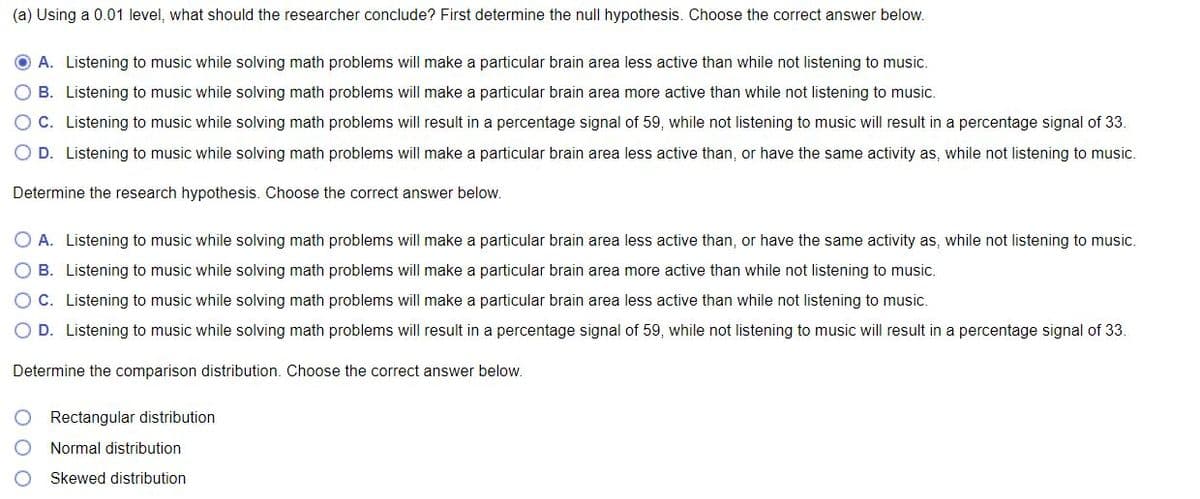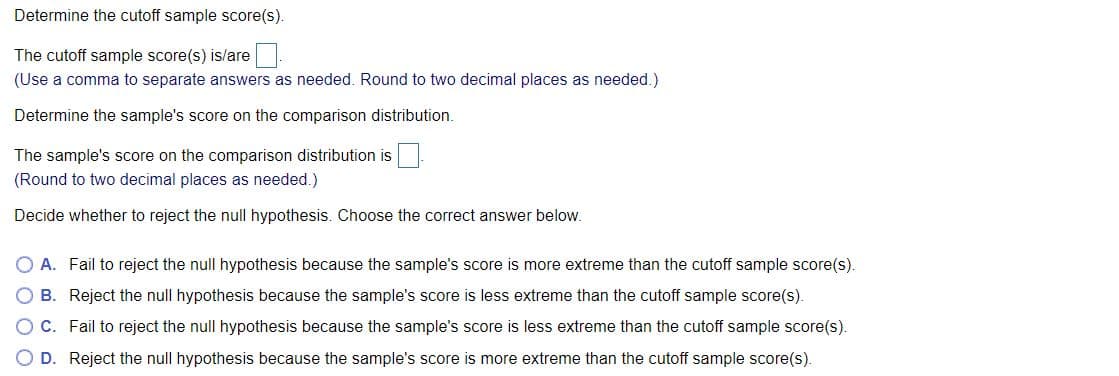Determine the cutoff sample score(s). The cutoff sample score(s) is/are. (Use a comma to separate answers as needed. Round to two decimal places as needed.) Determine the sample's score on the comparison distribution. The sample's score on the comparison distribution is (Round to two decimal places as needed.) Decide whether to reject the null hypothesis. Choose the correct answer below. O A. Fail to reject the null hypothesis because the sample's score is more extreme than the cutoff sample score(s). O B. Reject the null hypothesis because the sample's score is less extreme than the cutoff sample score(s). OC. Fail to reject the null hypothesis because the sample's score is less extreme than the cutoff sample score(s). OD. Reject the null hypothesis because the sample's score is more extreme than the cutoff sample score(s).
Determine the cutoff sample score(s). The cutoff sample score(s) is/are. (Use a comma to separate answers as needed. Round to two decimal places as needed.) Determine the sample's score on the comparison distribution. The sample's score on the comparison distribution is (Round to two decimal places as needed.) Decide whether to reject the null hypothesis. Choose the correct answer below. O A. Fail to reject the null hypothesis because the sample's score is more extreme than the cutoff sample score(s). O B. Reject the null hypothesis because the sample's score is less extreme than the cutoff sample score(s). OC. Fail to reject the null hypothesis because the sample's score is less extreme than the cutoff sample score(s). OD. Reject the null hypothesis because the sample's score is more extreme than the cutoff sample score(s).
MATLAB: An Introduction with Applications
6th Edition
ISBN:9781119256830
Author:Amos Gilat
Publisher:Amos Gilat
Chapter1: Starting With Matlab
Section: Chapter Questions
Problem 1P
Related questions
Question
SEE PICTURES AS WELL
A researcher predicts that listening to music while solving math problems will make a particular brain area more active. To test this, a research participant has her brain scanned while listening to music and solving math problems, and the brain area of interest has a percentage signal of 59 . From many previous studies with this same math problems procedure (but not listening to music), it is known that the signal change in this brain area is
(b) Explain your answer to someone who has never had a course in statistics (but who is familiar with mean, standard deviation, and Z scores).
Since the sample's score was
more
extreme than the cutoff sample score(s), that means the probability of that score occurring, given that the null hypothesis is true, is
less
than 0.01. With this knowledge, one can
fail to reject
the null hypothesis.Since the sample's score was
less
extreme than the cutoff sample score(s), that means the probability of that score occurring, given that the null hypothesis is true, is
greater
than 0.01. With this knowledge, one can
reject
the null hypothesis.Since the sample's score was
more
extreme than the cutoff sample score(s), that means the probability of that score occurring, given that the null hypothesis is true, is
less
than 0.01. With this knowledge, one can
reject
the null hypothesis.
Transcribed Image Text:(a) Using a 0.01 level, what should the researcher conclude? First determine the null hypothesis. Choose the correct answer below.
O A. Listening to music while solving math problems will make a particular brain area less active than while not listening to music.
B. Listening to music while solving math problems will make a particular brain area more active than while not listening to music.
O C. Listening to music while solving math problems will result in a percentage signal of 59, while not listening to music will result in a percentage signal of 33.
O D. Listening to music while solving math problems will make a particular brain area less active than, or have the same activity as, while not listening to music.
Determine the research hypothesis. Choose the correct answer below.
O A. Listening to music while solving math problems will make a particular brain area less active than, or have the same activity as, while not listening to music.
O B. Listening to music while solving math problems will make a particular brain area more active than while not listening to music.
OC. Listening to music while solving math problems will make a particular brain area less active than while not listening to music.
O D. Listening to music while solving math problems will result in a percentage signal of 59, while not listening to music will result in a percentage signal of 33.
Determine the comparison distribution. Choose the correct answer below.
Rectangular distribution
Normal distribution
Skewed distribution

Transcribed Image Text:Determine the cutoff sample score(s).
The cutoff sample score(s) is/are
(Use a comma to separate answers as needed. Round to two decimal places as needed.)
Determine the sample's score on the comparison distribution.
The sample's score on the comparison distribution is
(Round to two decimal places as needed.)
Decide whether to reject the null hypothesis. Choose the correct answer below.
A. Fail to reject the null hypothesis because the sample's score is more extreme than the cutoff sample score(s).
B. Reject the null hypothesis because the sample's score is less extreme than the cutoff sample score(s).
O C. Fail to reject the null hypothesis because the sample's score is less extreme than the cutoff sample score(s).
O D. Reject the null hypothesis because the sample's score is more extreme than the cutoff sample score(s).
Expert Solution
This question has been solved!
Explore an expertly crafted, step-by-step solution for a thorough understanding of key concepts.
This is a popular solution!
Trending now
This is a popular solution!
Step by step
Solved in 2 steps

Knowledge Booster
Learn more about
Need a deep-dive on the concept behind this application? Look no further. Learn more about this topic, statistics and related others by exploring similar questions and additional content below.Recommended textbooks for you

MATLAB: An Introduction with Applications
Statistics
ISBN:
9781119256830
Author:
Amos Gilat
Publisher:
John Wiley & Sons Inc

Probability and Statistics for Engineering and th…
Statistics
ISBN:
9781305251809
Author:
Jay L. Devore
Publisher:
Cengage Learning

Statistics for The Behavioral Sciences (MindTap C…
Statistics
ISBN:
9781305504912
Author:
Frederick J Gravetter, Larry B. Wallnau
Publisher:
Cengage Learning

MATLAB: An Introduction with Applications
Statistics
ISBN:
9781119256830
Author:
Amos Gilat
Publisher:
John Wiley & Sons Inc

Probability and Statistics for Engineering and th…
Statistics
ISBN:
9781305251809
Author:
Jay L. Devore
Publisher:
Cengage Learning

Statistics for The Behavioral Sciences (MindTap C…
Statistics
ISBN:
9781305504912
Author:
Frederick J Gravetter, Larry B. Wallnau
Publisher:
Cengage Learning

Elementary Statistics: Picturing the World (7th E…
Statistics
ISBN:
9780134683416
Author:
Ron Larson, Betsy Farber
Publisher:
PEARSON

The Basic Practice of Statistics
Statistics
ISBN:
9781319042578
Author:
David S. Moore, William I. Notz, Michael A. Fligner
Publisher:
W. H. Freeman

Introduction to the Practice of Statistics
Statistics
ISBN:
9781319013387
Author:
David S. Moore, George P. McCabe, Bruce A. Craig
Publisher:
W. H. Freeman